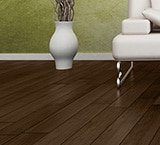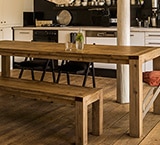Buying an item made from reclaimed wood adds character and history to your home, as it carries knots, defects and minor splits and cracks that you may not find in something brand new and bespoke. A reclaimed wood dining table, for example, can be a great addition to your dining room, but the upkeep may seem intimidating. But with some proper protection and care, you can make these unique furniture pieces last a lifetime. Here's what you need to know to get you started:
PROTECT IT
Was your reclaimed wood table finished before you bought it or will you be applying your own protection? If not, varnish, polyurethane and lacquer are some of the most common and durable finishes you can apply in a properly ventilated space at home. Where a varnish can feel very smooth and gloss-like once dry, an oil will still allow you to feel the details in the grain. Oil finishes (including Danish and Tung oils) offer a more organic look by soaking deep in to the pores of your reclaimed wood and highlighting what's hidden beneath the surface. But an oil finish may require regular upkeep on average, one fresh coat every three or four years.
Once you choose your finish, you must decide on your tools of application brushes versus cloth wipes. When you paint, for example, do you confident in your brush work or do you reach for the roller every time? If the later is true, you may not enjoy working with a finishing brush and should opt for cloth wipes for an easier application. Another benefit of cloth is that you can rub and buff an oil finish until your face reflects within the surface, but brushing doesn't have much room for error and over-brushing can leave areas looking less professional. Whatever finish you choose, know that perfection isn't necessarily the goal any small imperfections you add in the coating process with add it the table's character.
TAKE CARE OF IT
Even with the proper protecting finishes in place, reclaimed wood is still delicate and is prone to warping, discoloration and staining. You should keep your reclaimed wood dining table out of direct sunlight, and if it's an outdoor piece, place it in the shade. It's also best to avoid exposing your reclaimed wood to intense heat or moisture. Make sure you clean up spills immediately to avoid stains and rest hot dishes on trivets or hot pads to protect the surface from burn marks.
When it's time to clean up, wipe dust off with a lint-free cloth. It may be a good idea to invest in a small brush to help you remove crumbs, dust and other small debris from those hard-to-reach nooks and crannies. For a deeper clean, simple, natural cleaners work best: A blend of vinegar and water works well on unfinished pieces, and a natural cleaner, similar to Murphy® Oil Soap Original Wood Cleaner, is gentle enough to clean treated, reclaimed wood and still preserve and protect that unique character.
Caring and protecting reclaimed wood furniture pieces isn't nearly as intimidating as it seems. With some strategic finishes and smart cleaning habits, you'll lengthen the life of your dining table for a long time to come.











